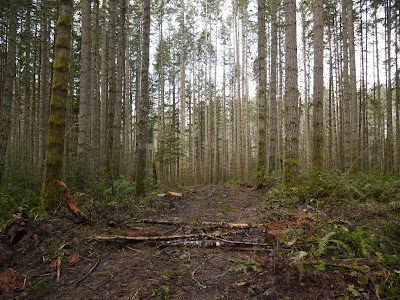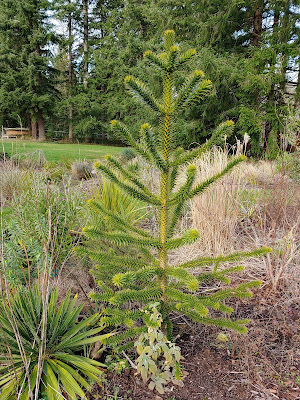A look at Seaquest State Park
It's been a while since I posted pictures from Seaquest. Last fall, the park had some logging done. Locals, including my family, were worried that the "thinning" would be a pilfering of large trees from the park, a desperate move necessitated by federal budget cuts, leaving only young or weak trees in the places that were being thinned. I'm glad to say our concerns were unfounded. Though there is obvious disturbance to the park, the logging was thoughtfully done, leaving trees in a range of sizes and opening up areas that were genuinely too dense. Most of what was removed seems to have been Douglas firs, leaving more western hemlock, western red cedar, and other trees to grow. Seaquest State Park, like many areas of the PNW, was hit hard by the Columbus Day Storm of 1962. Afterwards, Douglas firs were planted because of their timber value, leaving the canopy of the park unbalanced compared to the prior, more natural range of species.
So, while areas of the park may look terrible, I think the park will be healthier for it. The undergrowth will return, stronger than before, maybe even with a few other species that could only find enough light at the edge of the park before.
So, here are a few images from the park, post-logging. By a few, I mean lots, so the pictures are smaller, but you can see larger versions by clicking on them.
The largest of several clearings that had to be made as central points for collecting logs and loading them onto trucks. These are the worst areas. My only real concern is that the soil in these areas is probably compacted now. However, there is a healthy underground ecosystem to help remediate the soil structure. Forest clearings are actually quite important ecologically, so these areas may become rather interesting as the vegetation returns.
I was a little surprised that the logging crew actually managed to preserve most of the existing trail. It's also flagged for good measure.
On the edge of the logging. You can see some detritus piled up at the bottom edge of the photo, but looking off into the distance, you can't even tell anything was done.
This area looks so thin now. So much sky visible through the canopy. But the remaining trees will have more resources available to them, and the canopy will fill back in and be healthier. See how little foliage there is at the tops of some of those trees? Those trees needed more room, more light, more everything.
The loggers did a good job leaving young trees like this western hemlock, which will probably grow faster now to take advantage of the openings in the canopy, as they would naturally.
I was concerned about the small treasures in the park, like Goodyera oblongifolia, or rattlesnake plantain, but there are still plenty of areas where they remain untouched.
Away from the logged areas, the park looks the same as always.
Rough tracks run through the park now, from the logging. I heard about some improvements planned for the park after the logging. Some of these logging tracks would make nice trails into previously inaccessible areas of the park.
Logging was one reason I avoided the park for the last few months. Of course, I rarely walk the park during the rainy months, anyway. Some of the paths become rather wet and muddy. Here, a mole tunnel has become a spring in the pathway.
The mole tunnel spring flows down to a small seasonal creek that is spanned by a small bridge.
This area wasn't logged. It was already fairly open and is mostly populated by red alder. It's a much different view with the bare branches. This spot drew the eye upward.
One of my favorite mosses, step moss (Hylocomium splendens) dries out a little in the summer, but is lush this time of year. It gets the name step moss from the interesting growth pattern. A new "frond" grows from near the tip of the previous one, repeating one after the other, and forms a step-like chain.
This area of the park was extremely dense, full of spindly, sickly trees. It's also a higher and drier area of the park. Between the dense canopy and drier soil, there's hardly any undergrowth beyond the sword ferns in the foreground. Frankly, they probably could have taken more from this area. Parts of it beyond the frame of this shot are still very dense.
The park always has a few downed trees. No surprise this year with all the rain and wind.
Another section of trail-turned-stream.
Now we're out of the park itself and walking the path along Silver Lake. This stump was interesting in the way the wood inside had sunken, leaving a rim of bark like a natural container.
Some local delinquent has been cutting and stripping the bark from the trees along the lake. I wonder how they'd enjoy being flayed? Yes, I have little sympathy for people who do things like this, and I may overreact a touch.
Looking away from the mutilated trees across the lake. On a clear day, you can see Mt. St. Helens in the distance. Today, as on most days, clouds obscured the volcano.
Hope you're enjoying this warm weather. I spent yesterday at the Hoyt Arboretum (post to follow) and am planning another adventure today.
So, while areas of the park may look terrible, I think the park will be healthier for it. The undergrowth will return, stronger than before, maybe even with a few other species that could only find enough light at the edge of the park before.
So, here are a few images from the park, post-logging. By a few, I mean lots, so the pictures are smaller, but you can see larger versions by clicking on them.
The largest of several clearings that had to be made as central points for collecting logs and loading them onto trucks. These are the worst areas. My only real concern is that the soil in these areas is probably compacted now. However, there is a healthy underground ecosystem to help remediate the soil structure. Forest clearings are actually quite important ecologically, so these areas may become rather interesting as the vegetation returns.
I was a little surprised that the logging crew actually managed to preserve most of the existing trail. It's also flagged for good measure.
On the edge of the logging. You can see some detritus piled up at the bottom edge of the photo, but looking off into the distance, you can't even tell anything was done.
This area looks so thin now. So much sky visible through the canopy. But the remaining trees will have more resources available to them, and the canopy will fill back in and be healthier. See how little foliage there is at the tops of some of those trees? Those trees needed more room, more light, more everything.
The loggers did a good job leaving young trees like this western hemlock, which will probably grow faster now to take advantage of the openings in the canopy, as they would naturally.
I was concerned about the small treasures in the park, like Goodyera oblongifolia, or rattlesnake plantain, but there are still plenty of areas where they remain untouched.
Away from the logged areas, the park looks the same as always.
Rough tracks run through the park now, from the logging. I heard about some improvements planned for the park after the logging. Some of these logging tracks would make nice trails into previously inaccessible areas of the park.
Logging was one reason I avoided the park for the last few months. Of course, I rarely walk the park during the rainy months, anyway. Some of the paths become rather wet and muddy. Here, a mole tunnel has become a spring in the pathway.
The mole tunnel spring flows down to a small seasonal creek that is spanned by a small bridge.
This area wasn't logged. It was already fairly open and is mostly populated by red alder. It's a much different view with the bare branches. This spot drew the eye upward.
One of my favorite mosses, step moss (Hylocomium splendens) dries out a little in the summer, but is lush this time of year. It gets the name step moss from the interesting growth pattern. A new "frond" grows from near the tip of the previous one, repeating one after the other, and forms a step-like chain.
This area of the park was extremely dense, full of spindly, sickly trees. It's also a higher and drier area of the park. Between the dense canopy and drier soil, there's hardly any undergrowth beyond the sword ferns in the foreground. Frankly, they probably could have taken more from this area. Parts of it beyond the frame of this shot are still very dense.
The park always has a few downed trees. No surprise this year with all the rain and wind.
Another section of trail-turned-stream.
Now we're out of the park itself and walking the path along Silver Lake. This stump was interesting in the way the wood inside had sunken, leaving a rim of bark like a natural container.
Some local delinquent has been cutting and stripping the bark from the trees along the lake. I wonder how they'd enjoy being flayed? Yes, I have little sympathy for people who do things like this, and I may overreact a touch.
Looking away from the mutilated trees across the lake. On a clear day, you can see Mt. St. Helens in the distance. Today, as on most days, clouds obscured the volcano.
Hope you're enjoying this warm weather. I spent yesterday at the Hoyt Arboretum (post to follow) and am planning another adventure today.



































Thankfully, logging practices had advance so much; 'surgical' clearing is not our grandfather's logging. Destruction of nature evokes a visceral reaction in me too. Is it so different from torture of animals? What would be proper punishment for such behavior? I do have a few ideas...
ReplyDeleteThat last photograph is extremely beautiful, clouds and all.
Yes, thank goodness for progressive logging techniques. Despite knowing that, I was still worried it would be more about the loggers making money than actually improving the park. Glad to see that wasn't the case.
DeleteYou have whetted my appetite...think I'll go out for a walk in our woods.
ReplyDeleteThe weather's great for it!
DeleteI'm glad to hear that the logging was done in such a thoughtful way. Maybe some folks ARE getting smarter.
ReplyDeleteStep moss!!!
ReplyDeleteGlad I got to come along on your walk in the woods, Evan. I think I'm going to have to solicit your help in ID-ing some lichens when I get back from Sweden. Some of them are crazy cool!
ReplyDelete